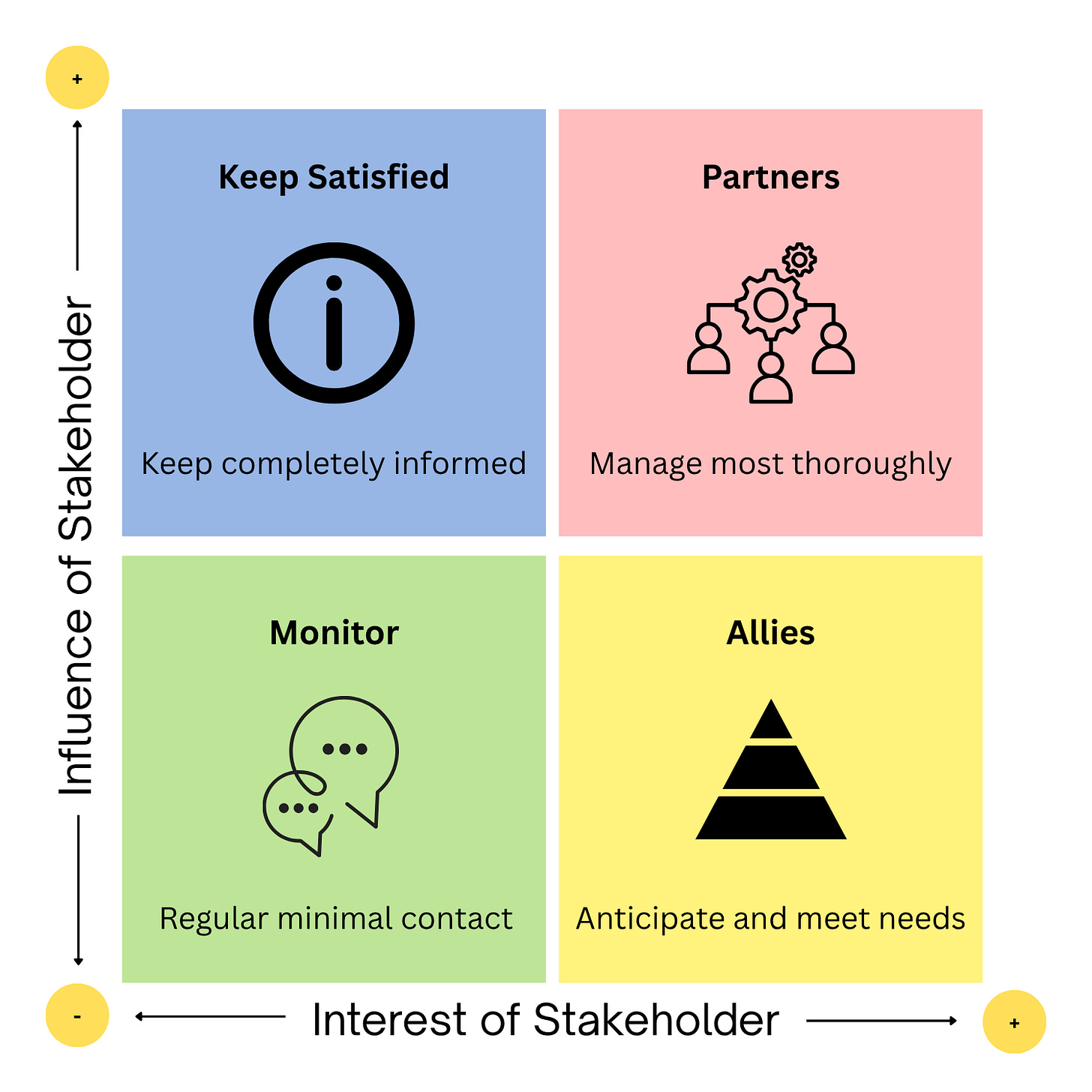The product manager’s antidote to “drive-by” feedback
Spend five minutes with this template to stay on top of stakeholder requests and avoid last minute surprises before launch.
We’ve all been there. You’re so close to launching. Your team has made the impossible happen. The designs are polished and the code is (nearly) stable. Then, in a final review meeting, a team or VP you barely get to speak makes a point that sends you back to the drawing board.
Launch gets pushed again, the team feel deflated, and you’re left kicking yourself that you didn’t see it coming.
If you’ve been managing your stakeholders based on seniority alone, you might find yourself feeling more reactive than proactive with these kind of requests (“It’s only 3SP, I’m sure we can squeeze it in if we push the tech debt ticket back again”).
But seniority alone won’t explain the interest, influence, or best method of managing stakeholders. Valid concerns can come from anyone up, down, or sideways. If they’ve not been on the journey with you, it’s normal for them to flock around your product with “drive-by” feedback the closer you are to launching it – because it all of a sudden feels very real.
Yes, you should bring them in sooner. No, this does not mean you have to book in progress calls with everyone and their dog. Save yourself the mental overload, chuck out the org map and use a stakeholder alignment canvas to stop getting blindsided.
What is the Stakeholder Alignment Canvas?
Think of it as a one-page, living document that moves beyond seniority to plot stakeholders on axes of influence (their power to advance or block your project) and interest (how much they care about the day-to-day outcome of it).
Yes, it’s another PM canvas (sorry, I also get framework fatigue). But this isn’t an artefact that needs to be polished or shared. I keep a scrappy, private version on Miro that I update from time-to-time to close the loop on who needs a progress update. It helps keep me honest about political realities and gives a clear comms plan for the people that matter.
You’ll need to place each stakeholder into one of the four quadrants, but there’s a rough strategy to understanding each category. That’s the key to clearing your head and getting the answers you need.
Partners: High Interest, High Influence
These are your project’s make-or-breaks, like a key executive sponsor or the head of a dependent engineering team. It could also be your direct manager but don’t only treat this group like someone you report into, they’re also people to collaborate with.
Actions
Bring them into the discovery process and get their input on problems, not just their sign-off on solutions.
Schedule short, frequent, focused sessions (e.g. 15m sync a week)
Never let them be surprised. Good and bad news should come from you first.
Keep Satisfied: Low Interest, High Influence
This group also has the power to advance or block your project. Think Head of Legal or Finance and will want to know if something goes wrong or affects their domain. They’re less concerned with the gritty details, but their lack of proximity doesn’t mean you push on in willing ignorance
Identify what they care about early-on, both from them and people around you who’s opinions you value
Communicate concise, high-level summaries tailored to their interests. Use bullet points and a RAG status if appropriate. Create this upfront, reuse and refine it.
Help them feel confident you’re proactively considering their needs, so there’s no need for them to dive in.
Allies: High Interest, Low Influence
Your cheerleaders! They might be colleagues who love what your building, vocal customer support reps, or power users. You’re not going to get that final sign off without their enthusiasm and ground-level knowledge. In my opinion this shapes the success of a product more than anything else.
They’re your best source of early feedback. Run informal demos and share low-fi updates regularly to course correct.
Equip them with key messages and data points so they can champion your project and set the record straight in meetings you’re not in.
Acknowledge and place value on their contributions throughout
Monitor: Low Interest, Low Influence
Time to breathe. The ‘monitor’ group are only tangentially connected to your work, so you can ease off the comms a bit. Don't waste time on 1-1s or custom reports.
Include relevant reps for different groups into general, automated comms (e.g. Show and Shares, company wide programme updates, etc.)
Revisit the canvas if a re-org or change in strategy shifts them into another group.
How To Use the Stakeholder Alignment Canvas
Take 5-10 minutes when you start a new project to brainstorm and plot your stakeholders. List every possible person who could be a stakeholder and plot them honestly onto the grid. This’ll probably be a private doc for you, but it can be useful to get a second opinion. Otherwise, just revisit the canvas and correct yourself as you go if your groups are wrong initially.
Consider the ‘Ask’ (What do I need from them to succeed?) and the ‘Offer’ (What can my project do for them) for each stakeholder. Create some comms templates based on this to ensure your updates are focused, quick to update, and able to give you what you need in return.
Review and evolve if dynamics shift and be ready to adapt your strategy! You probably won’t get this 100% right upfront but the ecosystem will become clearer as you go.
Although the canvas takes some time upfront, you’ll more than pay yourself back as the project goes on, by being clued up on their expectations and input so that you can focus on building what matters. Goodbye “drive-by” feedback!






